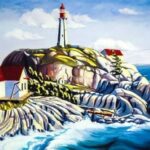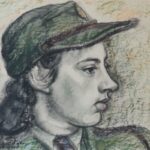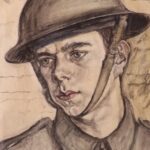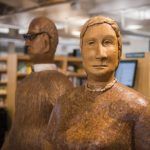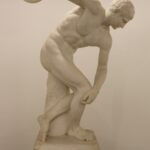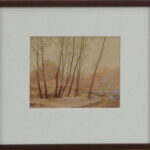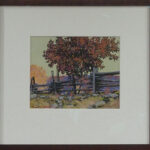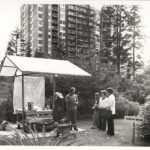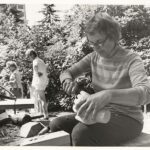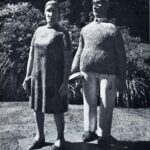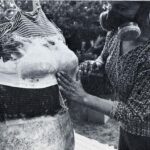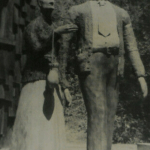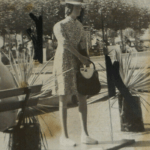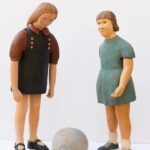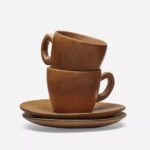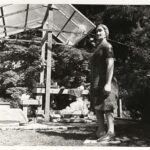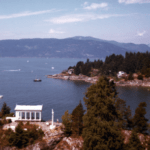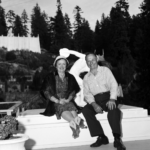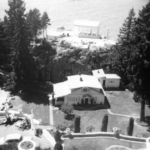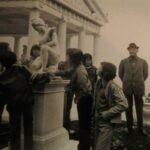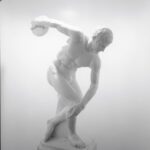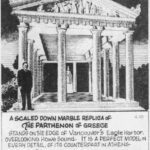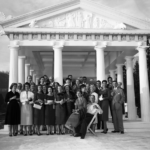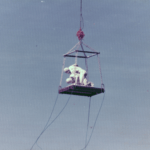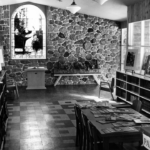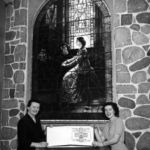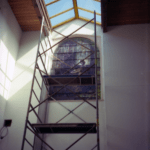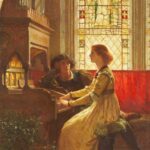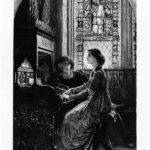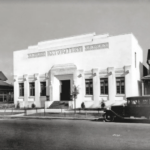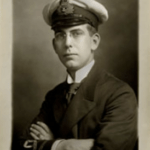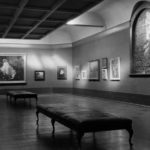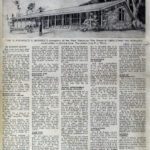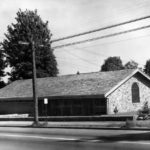Welcome to the Collection
Over the years, the Library has acquired a collection of high quality fine art that’s sure to delight, intrigue and inspire. We introduce you here to our most prominent pieces and invite you to appreciate them more fully the next time you visit us in person.
Learn about the pieces in our permanent art collection
Sch’etxw tl’a snewíyelh: Kwu7s iy S7áynixw / Panel of Knowledge: Tyee Salmon and Eulachon by Halikium/Wade Baker; Waterjet cut and hand polished aluminum.
Location: Main Hall.
Descended from ancient Skwxwú7mesh/Squamish, xwmə0kwəy̓m/ Musqueam, Kwakwaka’wakw/Kwakiutl and Tlingit nobility, Halikium/Wade Baker inherited a rich artistic legacy. This work of art is created through the time-honoured traditions and stories of the Coast Salish Peoples, passed down to him through tribal lineage and oral storytelling.
The Coast Salish Peoples revere all living things within their lands and waters. This art panel depicts both male (hooked nose) and female Tyee salmon swimming in unison with a school of eulachon smelt. The Tyee, translated as “the Chief,” represents the community’s knowledge keepers as they guide and mentor the eulachon, which represent the learners. The eulachon have long been a symbol of prosperity, as they feed the salmon and are thus essential to the life of the community. In fact, in many areas, the eulachon returned at a time of year when other food supplies were scarce, making them second only to salmon in importance as a source of food and trade. Beyond this, the eulachon oil is harvested to provide candlelight for storytelling—the transfer of knowledge between elders and the younger generation.
Powerful teachings are embedded within the stories and artistic elements of the Coast Salish Peoples. Panel of Knowledge: Tyee Salmon and Eulachon is inspired by the natural beauty that surrounds the nearby Ch’tl’am Swa7lt/McDonald Creek and the Library—a gathering place for learners and knowledge keepers in the community.
Funding for this art commission generously provided by the WVML Friends of the Library.
Mr. & Mrs. Plumtree, by Barbara Spring; Woodcarving.
Location: Main Hall.
First acquired in 1977, Mrs. Plumtree and her husband Carver Plumtree greet everyone at the Library door. Young children, in particular, make fast friends with these folksy wood sculptures, holding their hands, nattering away at them, and even taking a curious peek under Mrs. Plumtree’s dress—which the American artist created from an old dress coated in resin and fibreglass. Both Plumtrees are part of the West Vancouver Public Art Inventory Collection.
These wooden sculptures have called the Library home since they were created at the Wood Sculpture of the Americas Symposium, held in West Vancouver, in 1977. The work of acclaimed American wood carver Barbara Spring (1917 – 2011), they have become important fixtures at the Library for newcomers and longstanding patrons alike.In 2015 Mr. and Mrs. Plumtree were restored by Straight Line Designs. The West Vancouver Public Art Advisory committee approved funding for the restoration and facilitated the work to return these sculptures to a condition which allows for their continued presence at the Library. (Five degraded wooden bicycles that were also part of the 1977 Wood Sculpture of the Americas Symposium were also restored to near mint condition and are on display at the West Vancouver Community Centre.)Barbara Spring was born in Essex, England in 1917. At the end of the Second World War, during which she served in the Women’s Royal Air Force, she emigrated to the U.S. as a war bride. She and her husband moved to Big Sur, California in the early 1970s where Barbara remained until her death in 2011. Barbara was a talented and widely respected wood carver whose work was exhibited extensively. Barbara Spring is considered one of the leading artists from the San Francisco Bay Region Art Movement during the 1960s and 70s.
Harmony, by John Henry Dearle; Stained glass window.
Location: Main Hall.
In 1931, Henry Stone, a founder of the Vancouver Art Gallery, and his wife Beatrice commissioned John Henry Dearle, master craftsman and chief designer for the London firm Morris & Co., to create this breathtaking reproduction of Sir Frank Dicksee’s painting, “Harmony,” as a memorial to their son, Lieut. Horace Gordon Stone, who died in active service in 1918. The Art Gallery displayed the window until the Second World War, when it was removed for safekeeping. After the war, the window was given to Lieut. Stone’s sister, Mrs. Allan S. Gentles. When the West Vancouver Memorial Library was constructed in 1950 as a memorial to honour those who gave their lives during World War II, Mrs. Gentles presented the Library with the window, which has been a prominent feature of our building ever since.
Diskobolos, by Myron (replica); Stone sculpture.
Location: Main Floor.
Those looking for a large print book, enjoying the Musto Lounge, or quietly studying can see a reproduction of Myron’s “Diskabolos” (“Discus Thrower”), a famous Greek sculpture circa 450 BC known for its harmony and balance. Made of composite alabaster, this hand-finished piece was donated to the District of West Vancouver in 1973 by Nick Kogos.
Spring—Just Around the Corner and The Old Rail Fence, by Franz Johnston; Paintings.
Location: Main Floor, Musto Lounge.
Johnston is one of the original Group of Seven. Donated to the Library in memory of Herbert and Thelma Jamieson, his atmospheric watercolours depict a truly Canadian landscape. You’ll find them on the pillar near the Accessible Services office.
Point Atkinson Lighthouse, by D. M. Flather; Painting.
Location: Peter J. Peters Room.
The next time you relax with a magazine or newspaper in the Peters Reading Room, take a moment to enjoy the oil painting above the fireplace–arguably one of Flather’s finest works, painted in the late 1930s.
Unknown Woman Warrior, by Unity Bainbridge
Location: Main Hall
Unknown Soldier, by Unity Bainbridge
Location: Main Hall
Take a Deep Dive into our Permanent Art Collection
The Plumtrees
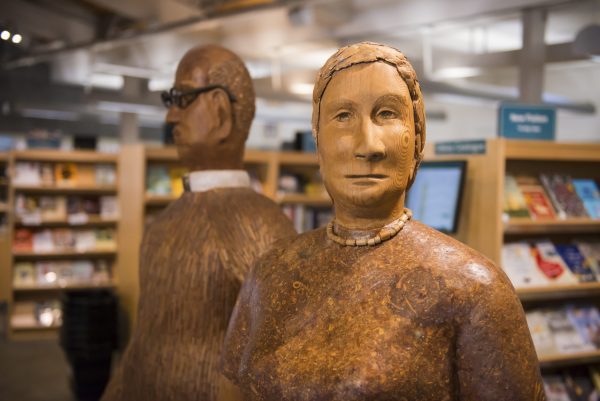
The Plumtrees have been greeting library visitors since they became a couple in 1977. Children love these charming wood sculptures and often chat with them, going in for a hug or trying to borrow the books they both hold. Created by the acclaimed American wood carver Barbara Spring (1917 – 2011), Mr. and Mrs. Plumtree have become important fixtures at the Library for both newcomers and longtime patrons. (Figures 1 and 2)
Barbara Spring was born in Essex, England, in 1917. She attended art school in England before serving in the Women’s Royal Air Force during the Second World War. Barbara emigrated to the U.S. as a war bride and moved to Big Sur, California, with her husband in the early 1970s, where she lived until her death in 2011. Even in her 90s, Barbara didn’t shy away from using a chainsaw, earning her a reputation as a trailblazer in American wood sculpting and as one of the standout artists from the San Francisco Bay Region Art Movement of the 1960s and 70s.
In the summer of 1977, following the success of a previous sculpture invitational, the Sculpture Symposium Society of B.C. selected ten renowned sculptors, including Barbara, from the United States, Venezuela, Colombia, and Canada to participate in the Wood Sculpture of the Americas Symposium in West Vancouver. From July 1 to August 15, these artists worked outdoors over the three-acres setting at Klee Wyck House Park (200 Keith Road). Their task was to create a collection of contemporary wood sculptures, which would eventually become permanent art installations across West Vancouver. The public was invited to watch the artists at work and engage with them during the six-week event. (Figures 3 and 4) The symposium was organized by the West Vancouver Arts Council in partnership with the District of West Vancouver, and it was sponsored by Park Royal Shopping Center. Thousands of people visited the outdoor event during this time.
Barbara did not always sculpt whimsical human figures from wood. She began her carving career making food items like hams, hot dogs, cakes, and even whole rounds of cheese. Soon enough, she was crafting teacups and experimenting with materials like fiberglass resin, wood chips, and sawdust to create stacks of plates, wooden dresses on hangers, and furniture. (Figures 5 and 6) When she was asked why she began making the quirky figures she lovingly called “My People,” she explained, “I wanted to make people to fit in with the things I had made.” (Figures 7, 8, and 9)
“With the people I always start with the shoes or the soles of the shoes, but the shoes are the very beginning of the character. Then I do the legs one by one and join them together. Then I start on the body which can be hollow or solid or both. I work from real clothes sometimes. I stuff them with sawdust to get shape, then I fibreglass them, tip out the sawdust and get a hollow form. I hung an old dress over Mrs. Plumtree that I’d dipped in resin, and then I laid fibreglass over the top of the dress to get the folds right. (Figure 10) And then I collected chips from everyone here: chain-sawed red cedar chips, yellow cedar from the lathe from which to make the patterns that I veneered over the dress underneath. Then I made the head and put it on; the hands and the book came last.”
Barbara Spring (1917 – 2011)
Fun Facts
- During the 1977 Wood Sculpture of the Americas Symposium, Japanese American sculptor Fumio Yoshimura (1926-2002) hand-carved the pair of glasses that sit atop Mr. Plumtree’s nose. Fumio worked near Barbara’s outdoor workshop on the Klee Wyck grounds, where he created five life-size wooden bicycles from various historical periods. Shortly after the symposium, these bicycles were installed at the entrance of Marks & Spencer, located on the south side of the Park Royal Shopping Center. Today, the sculptures have been newly refurbished and can be found suspended at various levels throughout the West Vancouver Community Centre Galleria. (Figure 11)
- Mr. Plumtree’s first name is “Carver.” Although the artist did not give Mrs. Plumtree a first name, library staff affectionately refer to her as “Willow.”
- Once the artist decided that the Plumtrees would reside permanently at the Library, she quickly carved several books to be affixed to the hands of both figures. Mrs. Plumtree carries a book titled Cast-Iron Cooking, while Mr. Plumtree holds the title The Confessions of Molly Bloom, which likely references the fictional character and wife of Leopold Bloom from the 1922 novel Ulysses by James Joyce.
More Images (use the arrows to scroll and click on an image to enlarge it)
The Discus Thrower (Discobolus)
Individuals seeking a peaceful reading spot might notice a small Greek sculpture illuminated within a column in the Library’s West Wing. The story of how this alabaster replica of the Discus Thrower (Discobolos) made its way to the Library is a fascinating part of our community’s unique history. (Figure 1)
Nick Kogos (1898-1979) was an interesting figure in the Vancouver business community. (Figure 2) He immigrated with his wife from Greece in the 1920s and was known as an ambitious restaurateur in the city, though he was also no stranger to criminal activities. Frequently of interest to the police, Kogos was arrested in 1921 on suspicion of burning down a restaurant he previously owned and had ties to the distribution of illicit drugs and alcohol. With the help of his business partner Johnny Dillias, he reopened the Commodore Cabaret in 1931, which was later renamed the Commodore Ballroom (870 Granville Street). The venue featured live music, a restaurant, and a beloved sprung dance floor—a hardwood surface laid over tires filled with horsehair to give it a distinctive bounce.
Kogos was deeply proud of his Greek heritage and actively engaged with the Greek community in Vancouver. To honour his roots and help his homesick wife, he purchased an estate above Balmy Beach in West Vancouver, south of Eagle Harbour. Over six acres, he constructed Greek-style retaining walls, terraced gardens, a large residence, and a miniature replica of the Parthenon, which sits atop the Acropolis in Athens, Greece. (Figure 3 and 4) Designed by the architectural firm Mercer and Mercer, construction of the 16 concrete columns, topped with a wooden and plaster structure, began in 1946. Kogos spent the next 20 years refining the site and collecting statues from abroad to display throughout the grounds. (Figure 5)
Ten pieces of statuary surrounded the mini-Parthenon. They included replicas of Athena, Aphrodite, Minera, Venus de Milo, Greco-Roman Wrestlers, and the Discus Thrower. Interestingly, none of the sculptures appeared to be carved by the same artist. They were scaled to different sizes, molded from various materials, and each represented a different Greek or Roman sculptural style. Thus, it can be inferred that the sculptures were not all from one workshop but likely created before 1940 and collected by the owner during his travels.
The Discobolus, or “Discus Thrower,” is one of the most iconic artworks of classical antiquity. Originally sculpted in bronze by the Athenian artist Myron of Eleutherae around 450 B.C.E, the statue has gained fame largely through its many bronze and marble Roman copies. The sculpture was well-known in the ancient world and has long been a symbol of athletic skill. The discus throw was one of the five events of the ancient Olympic pentathlon and remains one of the oldest and most iconic depictions of an Olympic sport.
Any discrepancies between the architectural style and historical accuracy of the Kogos grounds did not prevent the public or the media from touring the estate. Known as a popular party destination within the Greek community, the site was also a well-frequented tourist attraction for those passing by Eagle Harbour by boat or aircraft. (Figures 6 and 7) To this day, locals share stories of visiting the monument for Sunday picnics, enjoying it with classmates while studying Ancient Greece in elementary school, and even sneaking over the fence on a dare to dive off the Parthenon on hot summer days. (Figure 8)
Sadly, West Vancouver’s mini-Parthenon fell into disrepair. Before the property was sold and subdivided in the early 1970s, eight sculptures were removed and gifted to the District of West Vancouver. Heinz Berger, who became the municipal landscape architect for the District in 1961, was responsible for finding new homes for the gifted statues. The smaller pieces were moved relatively easily by Berger and his team, aided by a large flatbed truck. They were distributed to various viewing locations around West Vancouver, including the Seniors’ Activity Centre and the parking lot of Municipal Hall. In 1973, the sculptures Aphrodite and the Discus Thrower were gifted to the West Vancouver Memorial Library, although Aphrodite has since been removed from the Library’s courtyard and placed in storage. (Figure 9) The Wrestlers remained near the deteriorating Parthenon until 1976 when it was airlifted by helicopter, transported over the sea and up 17th Street, and installed on a concrete base at the entrance to Municipal Hall. (Figure 10) The Parthenon’s concrete pillars and rotting wood foundation were finally demolished in 1984. Today, all that remains of Nick Kogos’ tribute to Greek culture is the solitary figure of Minerva, standing on her cement pillar by the sea.
More Images (use the arrows to scroll and click on an image to enlarge it)
Harmony
The story of how the beautiful stained-glass window titled “Harmony” came to be displayed in the Main Hall of the West Vancouver Memorial Library begins nearly 150 years ago. In 1877, the English Victorian painter Sir Francis Dicksee (1853 – 1928) submitted an oil painting to London’s Royal Academy Summer Exhibition. Set within a medieval religious interior, his painting, “Harmony”, depicts a young man gazing adoringly at a woman playing a lavishly decorated organ. Light filters through a large stained-glass window, casting a warm glow over the musical scene. The accuracy and detail with which the artist portrays the stained glass, and the effect of filtering light may stem from his time spent assisting fellow artist and stained-glass designer Henry Holiday. (Figure 1)
“Harmony” was well-received at the Royal Academy and quickly became a favorite among the public and critics alike. Due to its popularity, the image was reproduced as a black-and-white etching by Charles Albert Waltner (1846 – 1925). (Figure 2) This reproduction provided an affordable fine art option for the growing market of amateur art collectors, while also making the image accessible to publishers of newspapers, journals, magazines, and books at a time when copyright laws were still developing. Many articles hailed the painting as the “Picture of the Year,” and the Tate Gallery swiftly acquired the masterpiece for their permanent collection. Dicksee went on to achieve significant success in his career when he became the President of the Royal Academy and received a knighthood in 1925.
As reflected in the work of Francis Dicksee and the larger body of work of his fellow Pre-Raphaelites, an artistic movement based on the revival of traditional techniques and lost craft knowledge was gaining momentum throughout the latter half of the 19th century. Known as the Arts and Crafts Movement, it was a reaction to a perceived decline in manufacturing standards associated with machinery and large-scale factory production. Artists and craftspeople presented designs and patterns that reimagined everything from architecture to domestic interiors, including wallpaper, carpet, light fixtures, and ceramic tile. The Movement celebrated the inherent beauty of nature and the value of high-quality craftsmanship.
William Morris (1834 – 1896) was a prominent figure in late 19th century design and had a significant influence on the Arts and Crafts Movement. In 1861, Morris founded Morris & Co. to provide fashionable British families with everything they needed to furnish their homes in the new Arts and Crafts style. The firm became a leader in producing textiles and large stained glass, featuring medieval themes, imagery, and strong bold colours. Their stained-glass workshop took on domestic commissions, allowing clients to choose unique illustrations or select from a catalogue of designs.
In 1882, businessman and amateur artist Henry Stone and his wife, Beatrice, moved from Britain to Canada. Around 1902, they settled in the Caulfeild area of West Vancouver. Henry was dedicated to fostering a vibrant arts community in Vancouver, which inspired him to donate $50,000 toward the establishment of a new art gallery. In 1931, he became the first president of the Vancouver Art Gallery and traveled across Europe to acquire a diverse collection of artworks for the gallery. (Figure 3) During this trip, the Stones met and commissioned John Henry Dearle, the principal art director of Morris & Co., to design a large stained-glass window in memory of their son, Lieutenant Horace Gordon Stone, who died while serving in the Royal Naval Volunteer Reserve (RNVR) during the Great War. (Figure 4)
It is unclear why the Stone family ultimately chose Sir Frank Dicksee’s painting “Harmony” as the memorial for their lost son. In 1877, “Harmony” was purchased for the nation by the Royal Academy using funds from the Chantrey Bequest. This bequest aimed to establish a public national collection of British fine art. Dicksee’s composition was the first painting acquired for this collection.
It’s likely that Dearle recognized the outstanding quality and the metaphorical significance of Dicksee’s original painting. Dearle designed a stained-glass window featuring a stained-glass window as its background, almost as a visual joke. The musical interior inhabited by the figures is actually a window that allows natural light to stream through.
The Stone family chose for Dearle’s stained-glass “Harmony” to be installed in Vancouver’s newly constructed Art Gallery, making it a cornerstone of the city’s art collection. Owning not only a splendid example of stained-glass artistry but also a replica of a well-known and critically acclaimed painting would make “Harmony” an attractive addition to any art collection. The “Harmony” window adorned the north wall of the Vancouver Art Gallery until the Second World War, at which point it was removed for safekeeping and placed in storage. (Figure 5)
After the war ended, the gallery began renovations to reshape the building’s façade and interior to accommodate 157 works donated by Emily Carr. The window was returned to Lieutenant Stone’s sister, Elsie Gentles, until a new home for the piece could be found. During this time, a public referendum was held in West Vancouver, deciding that the community’s new library would serve as the official War Memorial to honour West Vancouver’s fallen soldiers. The District’s Library Committee initiated a fundraising campaign, acquired land along Marine Drive across from the Memorial Arch, and enlisted architect Robert A.D. Berwick as the designer. From the beginning, the Library’s architectural plan included a memorial shrine to be located within the building’s west wall. Several early sketches of the Library’s west wall depicted a large wooden cross embedded within a stained-glass window, surrounded by locally sourced granite stonework. (Figure 6) It is unclear when the idea to replace the conceptual shrine with the “Harmony” window originated, but it is easy to see how Lieutenant Stone’s memorial window became a fitting addition to the interior of West Vancouver’s Memorial Library. The window was installed in the Library in 1951, one year after the official opening on November 11, 1950. (Figures 7, 8, and 9)
Ever since Elsie Gentles gifted “Harmony” to the community, it has remained a prominent feature of the West Vancouver Memorial Library. Renovations in 1976 and 1993 resulted in the window being first moved to the Second Floor, facing the Memorial Arch, and then returned to the Main Floor, where it now resides across from the front doors. (Figure 10)
More Images (use the arrows to scroll and click on an image to enlarge it)
The Offsite Collection
Among other drawings, paintings, sculptures, collages and tapestries, The West Vancouver Memorial Library’s permanent art collection also includes two watercolours by Emily Carr—The Chinese Gardener and Dead Man’s Island—currently held in the archives of the West Vancouver Art Museum.
 There will be noise in the Main Hall throughout March due to seismic upgrade work on the Mezzanine level.
There will be noise in the Main Hall throughout March due to seismic upgrade work on the Mezzanine level. 
